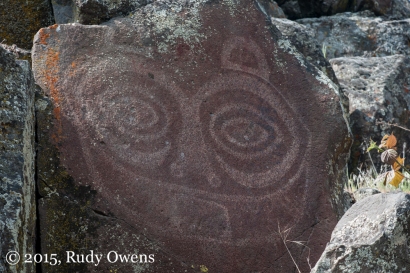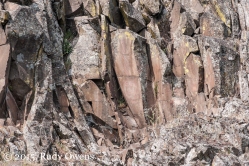Native Americans, according to archaeology records, lived continuously on the banks of the Columbia River for more than 12,000 years prior to their near demise due to new diseases and the arrival of white settlers in the 1800s. Their culture thrived because of trade among tribes and the stable supply of one of the world’s most nutritious natural food sources: migrating salmon and other fish species in the Columbia River.
The many generations of Native inhabitants also left behind a legacy of artwork, in the form of petroglyphs (rock carvings) and pictographs (paintings). The latter were mostly with white paints, derived from bones, and red paints, derived from blood. The age of these pieces of art are not fully known. They can be found in the region roughly east of Hood River and eastward for the next 40 or so miles. The residents who lived here at the time Lewis and Clark made their journey in the early 1800s on the river were known as the Wishram people.
Sadly, most of the art, the paintings and rock carvings, were flooded when the U.S. Army Corps of Engineers built dams on the Columbia, flooding historic village sites that had been settled since well before the rise of ancient Rome. A number of rock art carvings were salvaged and then reassembled in 2004 for public display at Columbia Hills State Park, in Washington state, near The Dalles, Oregon. The location of the art today was once the site of a thriving Native settlement. Today, the Yakama, Umatilla, and Warm Springs bands hold ceremonies here by their ancestors’ art, which was once on their ancestors’ land.
There is no written record describing the purpose of the art. Current theories suggest the artwork provide guideposts for dream quests, connecting the people to the spirit world. Other pictures also depict elements of folk myth, the most famous painting of all, “Tsagaglalal” or She Who Watches, derived from a story about coyote and clan matriarch who was cast into the rock and stood watch over her people. (The painting is now used as the logo for the Columbia River Interpretive Center.) This is considered one of the finest examples of Native American art in all of North America.
The petroglyphs today are accessible to all for the price of admission to the state park. To see the rock art paintings in an area with limited viewing, you need to call the park in advance and sign up for a guided interpretive tour, led by a park cultural interpreter or a Native American guide. This was one of the highlights of my regional outings in the Pacific Northwest.
I would recommend this trip to anyone, of any age. You find yourself in one of the most scenic areas in North America, standing on land where countless generations stood before you.
You can see some photos of this area and its former Native inhabitants in the collection of Edward Curtis, famed photodocumentarian of Native American people (including staged photos). His work is archived on a superb Smithsonian photo media archive. Look for pictures marked “Wishham” (note spelling differences from above).
Click on each photo to see a larger picture on a separate picture page.





